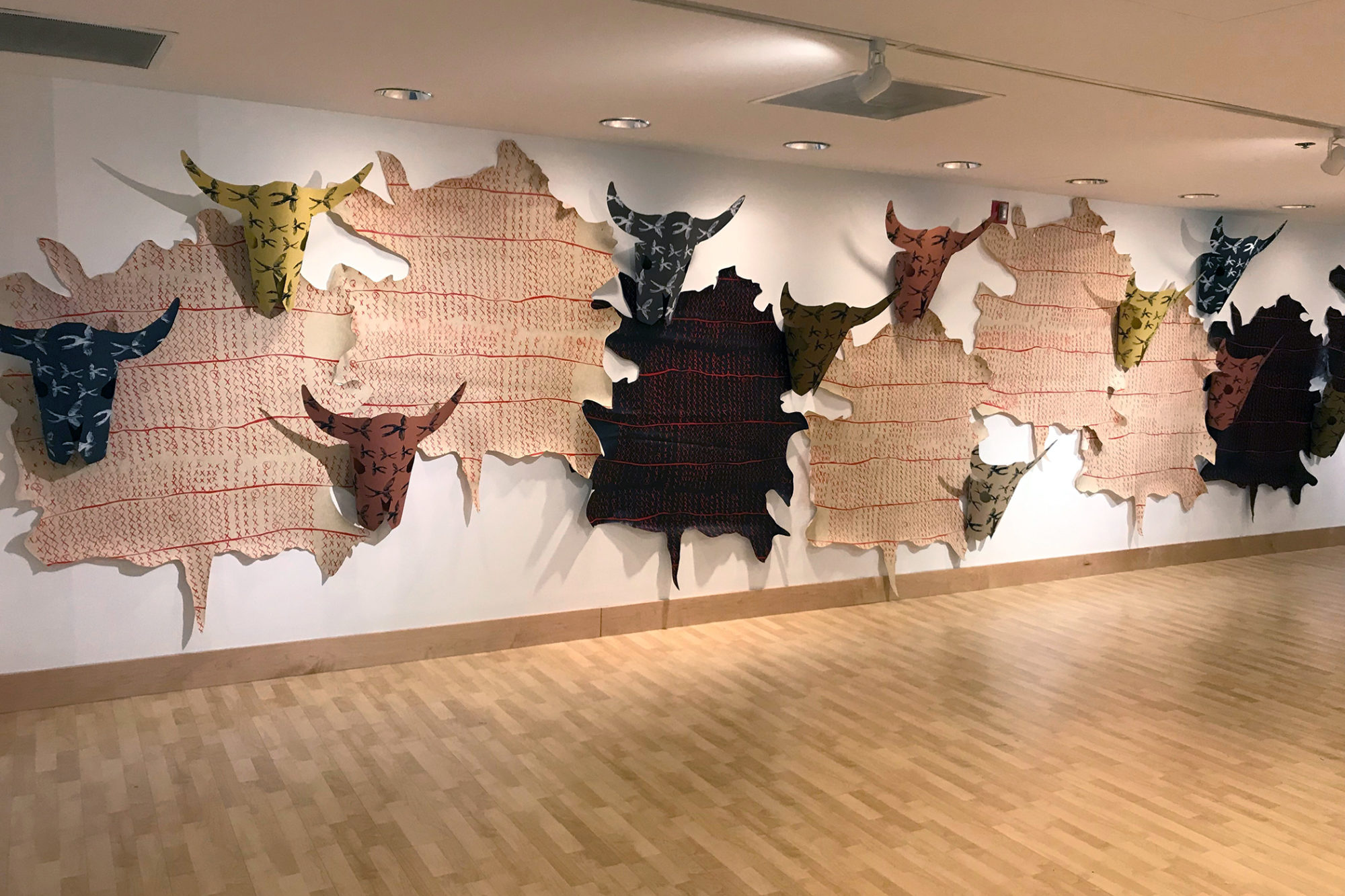John Hitchcock: Flatlander—Belonging to the Land
Reviewed by: Christina Schmid
Bethel University Art Gallery
Feb 7–Mar 24, 2019

It is not flattering to be called a flatlander. And yet, John Hitchcock turns mockery into a source of pride in his most recent solo exhibition. The prints on paper that make up the majority of the show are named after places where Hitchcock grew up: “Big Rock Rd”, “Otipoby Drive”, “Tackle Box Road”, and “Military Res Boundary Line”. Amid the current craze for genetic ancestry kits, Flatlander offers an altogether different take on genealogy and belonging.
More than simply suggesting rootedness, belonging to the land upends the logic of land as property: what if it was never ours to begin with? The deceptively simple switch subverts the biblical admonition “to go and take possession of the land” (Deuteronomy 1:8) and offers an indigenous ethos instead. Far from a divinely ordained economic resource to be exploited for maximum gain, land acts as teacher in Native pedagogy.[1] How provocative, then, to encounter Hitchcock’s Flatlander (previously exhibited at the Plains Art Museum in Fargo, the Mulvane Museum in Topeka, and The Ski Club in Milwaukee) at Bethel University, a Christian school where bible verses in large script run across the walls of communal spaces. But provocation is not Hitchcock’s point.
Three colorful flags lead the way to the gallery: “Paa tsa numunaina,” two of them proclaim in Comanche letters. “Water is Life.” The phrase brings to mind the 2016 protests against the Dakota Access Pipeline at Standing Rock, ND, where protesters acted as water protectors. “Water is Life” also echoes the voices of the Nibi River walkers, a group initiated by Anashinaabe grandmothers, determined to care for the water every day: “We are not a protest. We are a prayer,” they explain.[2] This ethos of reciprocity, of caring and being cared for, carries over to the central installation in Flatlander, “The Protectors (Buffalo)”.
Nine pieces of Naugahyde, cut to resemble buffalo hides, are mounted on a wall. Each is decorated with a geometric design that combines long horizontal red lines with dense columns of red x’s. Their color is reminiscent of the red pigment of petroglyphs found in northern Minnesota and southern Canada. The lines run more or less parallel; some resemble the gentle rise and fall of horizon lines in the Great Plains. A few x’s are circled, as if keeping count or tracking particularities. In between the faux skins, bison skulls constructed from bent paper jut out. The palette—yellow, brown, black—alludes to traditional Plains styles. Each paper skull is printed with a pattern of Scissor-tailed Flycatchers in flight. Before the elegant bird ever became Oklahoma’s state bird, indigenous birdwatchers knew it as hilowi-foshi’ or foshi’ ishkalasha’ hasimbish, the thunderbird of tribal stories.[3] Flitting across the paper skulls, the thunderbirds enliven a work that otherwise feels like a rather elegiac homage.
Hitchcock’s choice of material also deserves notice: skulls and hides are only represented, recognizably life-like in scale and proportion, but neither bone nor skin is on display. Naugahyde and paper act as placeholders for parts of revered animals whose presence, though invoked, is deliberately, carefully, withheld. This gesture of withholding not only demonstrates agency, it resonates as an act of sovereignty, a gesture familiar from other indigenous artists and thinkers working today. Not all should be shared. Hitchcock’s titular protectors—birds and buffalo—also deserve protection.
In his prints, Hitchcock’s visual language changes. Multiple layers blend geometric and grid-like motifs with imagery gleaned from any number of sources; helicopter blades and seed pods meet owl faces and bison heads amid dotted marks inspired by rock drawings. The compositions are cumulative and dense, a veritable thicket of visual clues. Like the flatlands the artist hails from, where clay, loam and sandstone make up the soil, the layers in his images accrue over time; they sediment, meta-morph and flatten. There is a rhythm in their playful vibrancy that allows for moments of recurrence and recognition; the quartered circle and the four-directions cross appear frequently. Individual works suggest movement, fast and centripetal, or contraction into a semblance of order. Flatlander thus grapples with belonging to the land as a dynamic interplay of personal and cultural histories, grounded, always, in the slow and ancient churn of geologic processes beneath our feet.
And yet, engaging the work feels like an educational exercise to me. That is not a bad thing. I treasure moments when art teaches me how to look. But what I learned by spending time with Flatlander I did not learn from the artwork directly but by following where the work led me: ethno-ornithology, water protectors, reservations and river walkers. I imagine, were I one of the students Hitchcock involved in the collaborative making of the prints, I would have learned even more, about process and creative decision-making, about which color to use for the initial wash and which layer to print in what order and color. Hitchcock added a layer of hand-drawn marks to some of the works. Encountering Flatlander in the gallery, without the playful (and precise) frenzy of process, makes me miss the excitement of their making in the final images. Maybe inciting excitement, like sparking provocation, is beside the point; maybe those are merely a mountain-lover’s values. Maybe lingering in the calm assurance of a lasting commitment is a flatlander’s way of belonging to the land.
